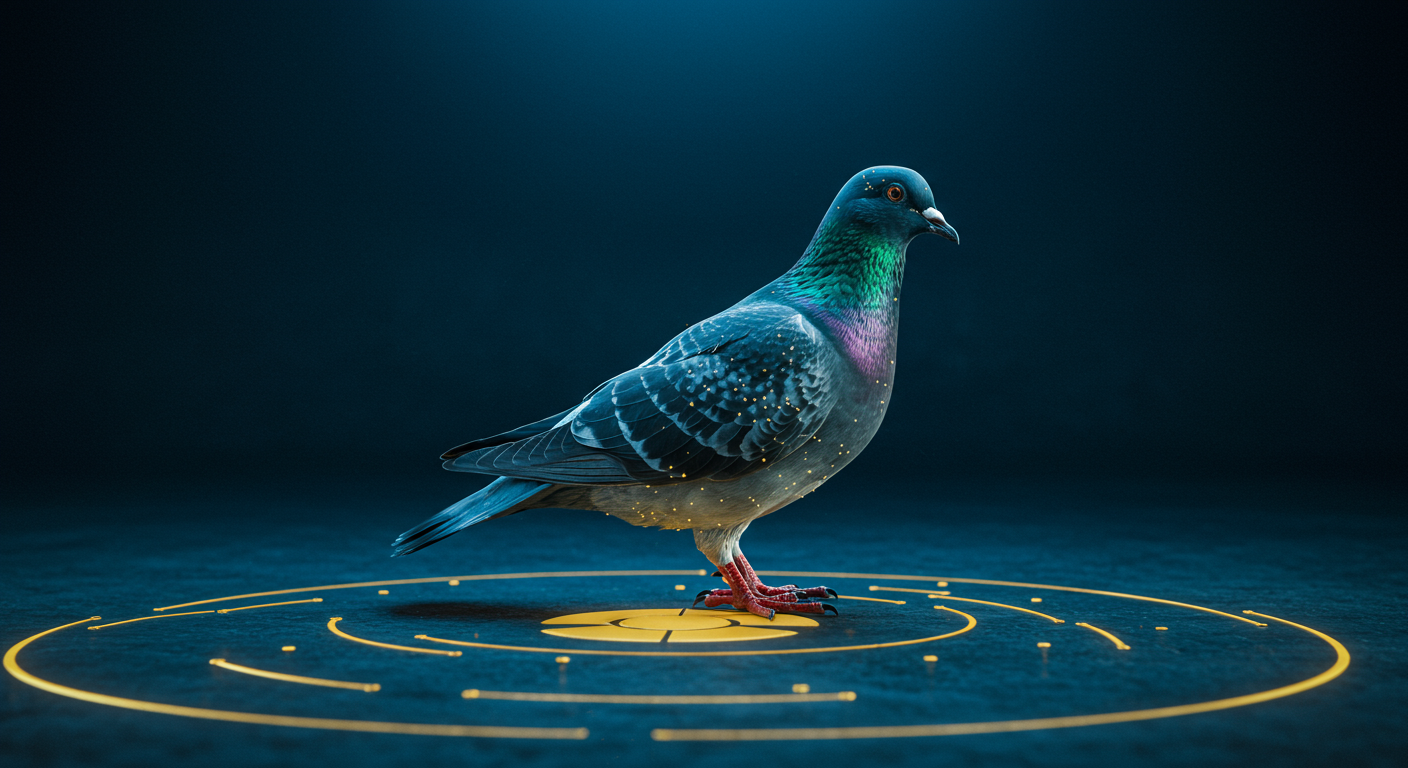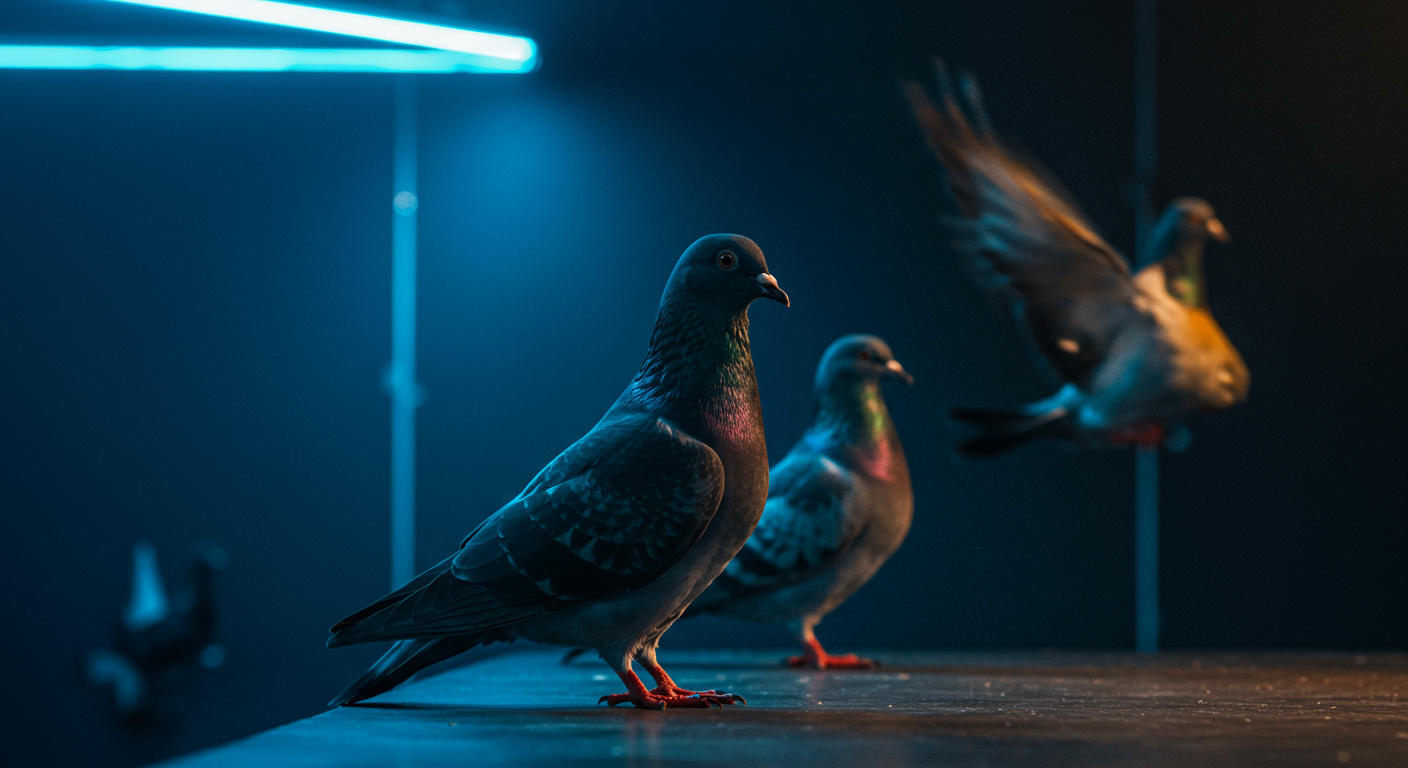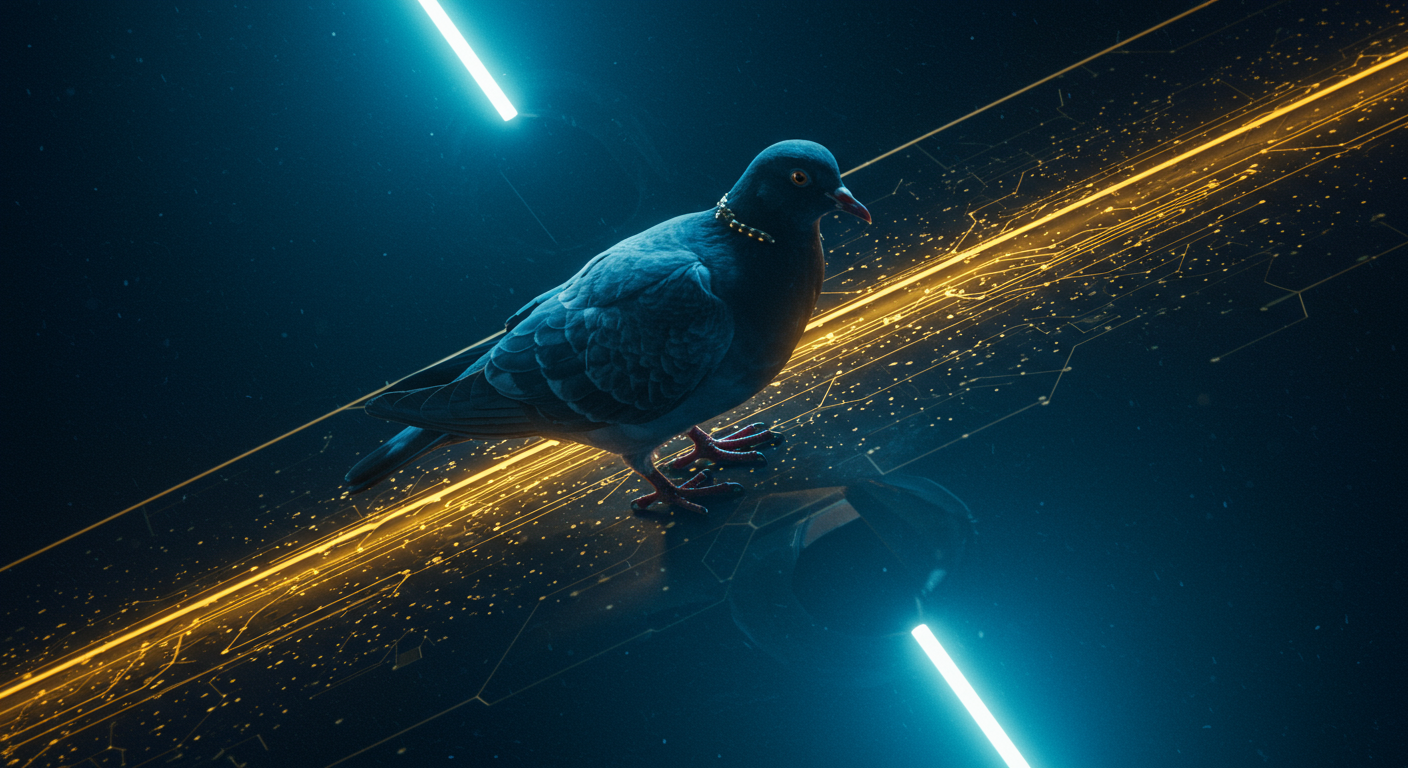From Project Pigeon to AI Powerhouse: How Avian Instincts Revolutionized Machine Learning

It sounds absurd, but the seeds of today's AI revolution were, in part, sown by studying the humble pigeon.
The Unlikely Muse: How Pigeons Secretly Shaped the AI Revolution
While we're busy debating the ethics of ChatGPT, let's not forget an earlier chapter in AI's development – one that involves feathered friends. Bio-inspired AI takes cues from nature, and in AI's formative years, researchers looked beyond complex biological systems to find simple, yet effective models.
Why Pigeons?
Early AI struggled with pattern recognition. Pigeons, however, excel at it! Their ability to discriminate between images, classify objects, and learn associations made them perfect subjects for behavioral experiments.Think of it this way: Training a pigeon to recognize a "rewarding" image is simpler and faster than trying to model the intricacies of the human brain.
The Skinner Box and Beyond
Psychologist B.F. Skinner's work on operant conditioning, using a "Skinner box" to train pigeons, demonstrated how reinforcement learning could shape behavior. This principle proved surprisingly relevant to AI.- Reinforcement learning: This core AI technique, where agents learn through trial and error, owes a debt to Skinner's work. Think of AI agents learning to play games – rewarding "good" moves and penalizing "bad" ones.
- Pattern Recognition: Pigeons demonstrated an innate capacity for pattern recognition, providing valuable insights for early image recognition algorithms. Today, this translates to Image Generation tools.
From Avian Brains to AI Gains
It’s a far cry from Skinner boxes to neural networks, but the principles remain. The study of pigeons, while seemingly unrelated, offered crucial lessons in learning and adaptation, which helped lay the groundwork for many AI algorithms we use today. As AI continues to evolve, expect more unlikely inspirations to emerge, maybe from slime mold next!Project Pigeon: When Birds Became Bomb Guides (and AI Pioneers)
While today's AI boasts neural networks and complex algorithms, its roots are surprisingly avian. During World War II, the need for precision-guided missiles spurred B.F. Skinner, a prominent figure in behavioral psychology, to explore an unconventional solution: pigeons.
Project Pigeon: Operant Conditioning in Action
The core idea behind Project Pigeon (also known as Project Orcon) was ingeniously simple:
- Training: Pigeons were trained using operant conditioning techniques. They were placed inside a missile nose cone and rewarded with food for pecking at an image of the target.
- Guidance: The pigeon's pecks, registered by a screen, would adjust the missile's fins, guiding it toward the target. Think of it as a very early, biological form of image recognition and course correction. B.F. Skinner's contribution to behavioral science was critical here.
Limitations of the Time
Despite the initial promise, Project Pigeon faced significant hurdles:
- Skepticism: The military was understandably wary of relying on birds for such a critical task. Trusting that a pigeon, rather than technology, was guiding a bomb required a leap of faith few were willing to take.
- Technological constraints: The technology to reliably translate a pigeon’s pecks into precise steering adjustments just wasn't there yet. The scientific research tools hadn't advanced far enough.
A Lesson Learned?
Ultimately, Project Pigeon was shelved, deemed impractical for the time. However, it provided a valuable lesson:
- Early AI Inspiration: It demonstrated the potential of using animal behavior for automated tasks. The basic principle of training a "system" (in this case, a pigeon) through rewards is foundational to many modern AI learning algorithms. Think of it as the AI Explorer of the era.
Skinner's quirky pigeon experiments, initially designed to understand animal behavior, unknowingly laid the foundation for AI's ability to learn from experience.
Skinner Boxes and Simulated Minds: Operant Conditioning's AI Legacy
The ABCs of Operant Conditioning
Operant conditioning, at its core, is learning through consequences. It's about associating actions with rewards or punishments. Think of it as nature's original algorithm, with the following key principles:- Positive Reinforcement: Adding something desirable (a treat, praise) to increase a behavior. Your dog gets a treat for sitting - they're more likely to sit again!
- Negative Reinforcement: Removing something unpleasant (a nagging sound, discomfort) to increase a behavior. Fastening your seatbelt stops the annoying car beep, encouraging you to buckle up in the future.
- Punishment: Introducing something undesirable (a scolding, electric shock (yikes!)) or removing something desirable (privileges) to decrease a behavior.
The Skinner Box: A Controlled Environment
The infamous Skinner box was a controlled environment where animals (typically rats or pigeons) learned to perform actions, like pressing a lever, to receive a reward. This allowed researchers to meticulously study the impact of different reinforcement schedules on behavior. This setup illustrates how behaviors can be shaped gradually – a process known as shaping, which is a core concept used later in AI training."Give me a child and I'll shape him into anything." - John B. Watson, a proponent of behaviorism (though not directly related to Skinner)
From Pigeons to Algorithms: Reinforcement Learning
Fast forward to today, and operant conditioning's principles are alive and well in AI. Reinforcement learning algorithms mimic the reward-punishment mechanisms of the Skinner box, but with code. These algorithms learn by interacting with an environment, receiving rewards for desirable actions and penalties for undesirable ones. Consider AI Dungeon, an AI-powered text adventure game, or similar conversational AI applications.Shaping the AI Brain
Just like in operant conditioning, concepts like shaping and extinction (the gradual disappearance of a learned behavior when reinforcement stops) are crucial in AI training. Reinforcement learning is used in various applications, from training AI to play complex games like chess to optimizing robotic movements and creating helpful AI tools for software developers.The legacy of Skinner's pigeons lives on, proving that even the simplest models of learning can inspire incredibly sophisticated AI systems. It's rather wonderful, isn't it? This foundation sets the stage for exploring more advanced AI learning techniques, which we'll get into next.
Pigeon Intelligence: More Than Just "Bird Brains"
Forget the stereotype of the simple "bird brain" – pigeons are surprisingly intelligent creatures, and their cognitive abilities have profoundly influenced the development of AI. It turns out, pigeon pattern recognition AI is a genuine area of research!
Avian Acumen
Contrary to popular belief, pigeons exhibit remarkable cognitive skills:
- Pattern Recognition: Pigeons can distinguish between complex visual patterns, even identifying different styles of art.
- Categorization: They can categorize objects and images, demonstrating a capacity for abstract thought, much like the AI models used in Design AI Tools.
- Navigation: Their incredible navigational skills, relying on visual landmarks and magnetic fields, have inspired AI algorithms for route optimization.
From Coop to Code

Researchers have drawn inspiration from the way pigeons process information, leading to innovative AI solutions:
- Image Recognition: Pigeon-inspired algorithms have been developed for image recognition tasks, mimicking their ability to quickly identify targets amidst clutter. This ties directly to how many image generation tools function.
- Facial Recognition: Studies have shown pigeons can even recognize individual human faces, a feat relevant to AI-powered facial recognition systems.
It might seem improbable, but the humble pigeon has unwittingly shaped some of today's most advanced AI.
From Avian Insights to Algorithmic Breakthroughs: Specific Examples

Here’s how researchers are borrowing from avian wisdom to create smarter algorithms:
- Pigeon-Inspired Search Algorithms: Just as pigeons efficiently forage for food, these algorithms explore search spaces. Imagine you're using Aiseo, an AI tool optimizing your website. At its core, it may employ a search algorithm borrowing from pigeon navigation, efficiently finding the optimal keywords. This is rooted in the observation that pigeons don't just randomly fly around; they seem to follow learned routes and adapt based on success, minimizing wasted energy. Mathematically, this translates to algorithms that prioritize exploration along promising paths while retaining the ability to discover new, potentially better options.
- Flocking Behavior for Swarm Intelligence: Pigeon flocking behavior, where birds maintain cohesion while avoiding collisions, is translated to Swarm Intelligence.
- Pigeon Navigation for Robot Pathfinding: Pigeons navigate complex environments with remarkable accuracy. Scientists are adapting the birds' strategies (using a combination of landmarks, magnetic fields, and the sun) to program robots that can navigate similarly tricky terrains. Consider a robot tasked with exploring a disaster zone. The AI in practice behind its pathfinding could be inspired by pigeon navigation, allowing it to adapt to unexpected obstacles and find the most efficient route. This allows for more robust and adaptable robotics that outperform systems reliant solely on GPS or pre-programmed paths.
It might seem strange, but those seemingly simple pigeons could unlock the next leap in avian inspired machine learning future.
Pigeons: Not as Bird-Brained as You Think
Pigeons possess remarkable cognitive abilities.- They can differentiate between objects, even in distorted images.
- They learn complex sequences.
- They can even recognize human faces.
Avian Inspiration for Next-Gen AI
How can these feathered friends inform AI?- Distributed Learning: Pigeons collaborate effectively within flocks; we could learn from this for improving decentralized AI systems.
- Adaptive Systems: Pigeons are incredibly adaptable to new environments; this adaptability inspires robust AI that can cope with unexpected situations.
- Reverse Engineering Potential: Imagine reverse-engineering a bird brain to create a more efficient AI!
The Future is Interdisciplinary
The real magic happens at the intersection of biology, psychology, and computer science. Interdisciplinary research is key to unlocking new avian inspired machine learning future. However, the ethical implications are significant. Exploiting animal behavior for AI needs careful consideration.In conclusion, pigeons aren't just city birds; they're potential keys to a more intelligent and adaptable AI future, demanding an ethical and collaborative approach to unlock their secrets. Now, let's look at...
Beyond the Coo: A Lasting Legacy
It’s astonishing to think that the humble pigeon helped lay the groundwork for some of today's most sophisticated AI.
Project Pigeon: More Than Just Birdbrains
Back in the 1940s, B.F. Skinner's Project Pigeon sought to use pigeons to guide missiles – admittedly, a bit 'out there,' even then. While the tech wasn't quite ready, the underlying principles were revolutionary:
- Shaping Behavior: Skinner demonstrated how to train pigeons through reinforcement learning, a technique now fundamental to AI. Think of it like teaching an AI to play chess: rewarding it for good moves.
- Pattern Recognition: Pigeons proved adept at recognizing visual patterns, a vital component in image generation and object detection – paving the way for things like self-driving cars.
Nature as a Neural Net
Project Pigeon reminds us of the critical role of nature as a blueprint for AI development. The bird's-eye view offers a surprisingly clear perspective on how brains – biological or silicon – can be trained to solve complex problems. Consider these points:
- Inspired Algorithms: Many AI algorithms mimic the structure and function of the brain. Looking at nature provides clues for designing more efficient and robust AI systems.
- Unexpected Insights: Studying seemingly simple creatures can reveal hidden computational capabilities. Perhaps the next breakthrough in conversational AI lies in how ants communicate.
From Avian Instincts to Future Innovation
The legacy of Project Pigeon goes beyond its immediate goals. It’s a testament to the power of interdisciplinary thinking, reminding us that innovation often arises from unexpected places. This unconventional experiment highlights the potential for discovery when we look beyond traditional sources for inspiration in AI research. What other seemingly simple creatures hold the secrets to the next AI breakthrough? Perhaps it's time to observe the octopus…
Keywords
pigeons AI, pigeon inspired AI, animal cognition AI, bio-inspired machine learning, pigeon role in AI development, Skinner box AI, operant conditioning AI, pigeon intelligence, AI history, pigeon contribution AI, avian cognition AI, animal learning algorithms
Hashtags
#PigeonAI #AIHistory #AnimalIntelligence #MachineLearning #BioInspiredAI
Recommended AI tools
ChatGPT
Conversational AI
AI research, productivity, and conversation—smarter thinking, deeper insights.
Sora
Video Generation
Create stunning, realistic videos and audio from text, images, or video—remix and collaborate with Sora, OpenAI’s advanced generative video app.
Google Gemini
Conversational AI
Your everyday Google AI assistant for creativity, research, and productivity
Perplexity
Search & Discovery
Clear answers from reliable sources, powered by AI.
DeepSeek
Conversational AI
Efficient open-weight AI models for advanced reasoning and research
Freepik AI Image Generator
Image Generation
Generate on-brand AI images from text, sketches, or photos—fast, realistic, and ready for commercial use.
About the Author

Written by
Dr. William Bobos
Dr. William Bobos (known as 'Dr. Bob') is a long-time AI expert focused on practical evaluations of AI tools and frameworks. He frequently tests new releases, reads academic papers, and tracks industry news to translate breakthroughs into real-world use. At Best AI Tools, he curates clear, actionable insights for builders, researchers, and decision-makers.
More from Dr.

